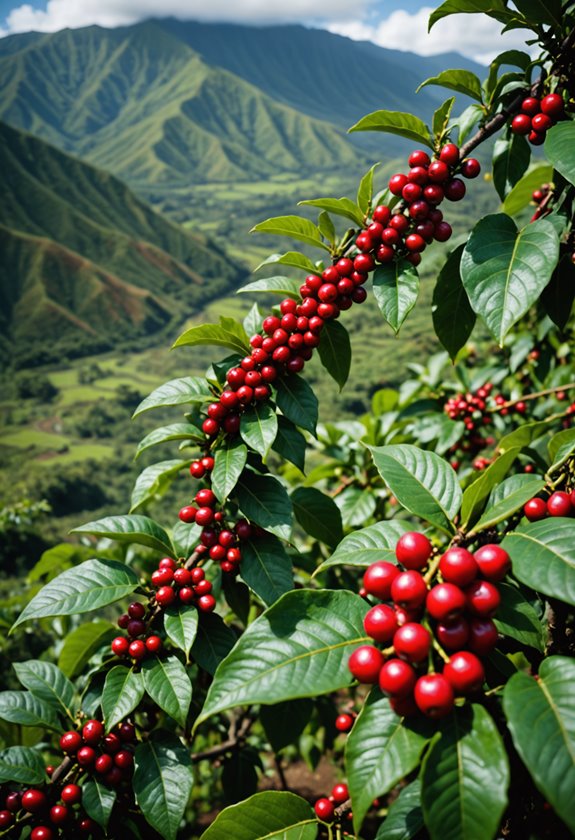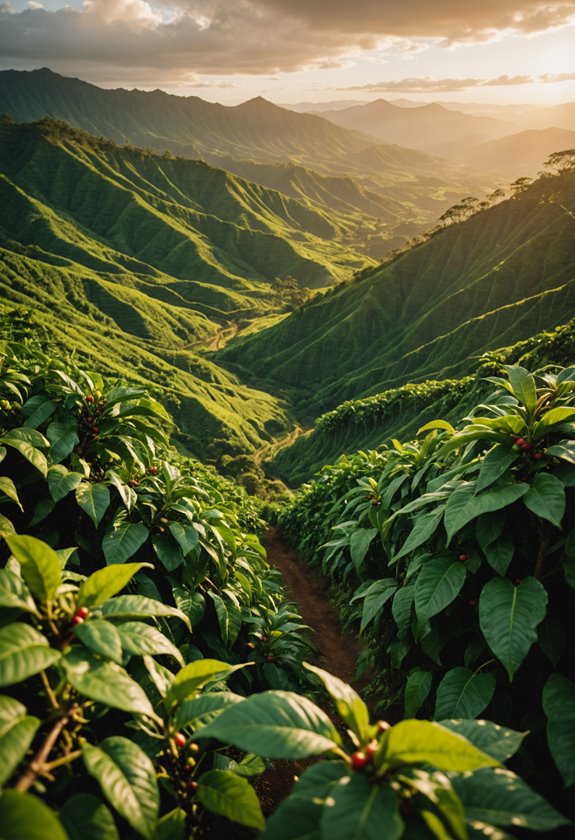Are Coffee Beans Grown in the USA?
You might be surprised to learn that coffee beans are grown in the USA, with Hawaii and California leading the way. Hawaii's Kona region, known for its volcanic soil, produces unique Arabica beans with smooth, nutty flavors. California, particularly in San Diego, has taken on coffee growing with innovative farms producing adventurous flavors. Coffee cultivation isn't major in the U.S., but specialty production is gaining traction, adding local, high-quality options. Challenges like climate change and water scarcity persist, yet opportunities in sustainable practices offer promise. There's much more to uncover about America's intriguing coffee-growing potential.
Key Takeaways
- Coffee beans are grown in the U.S., primarily in Hawaii and California.
- Hawaii's Kona region is renowned for high-quality Arabica beans with unique flavors.
- California has experimental coffee farms focusing on specialty Arabica beans.
- States like Texas and Florida are exploring coffee cultivation due to suitable climates.
- U.S. coffee production emphasizes specialty coffee with unique, locally-adapted flavors.
U.S. Coffee Growing Regions

Although coffee isn't a dominant crop in the U.S., there are a few regions where it thrives. Let's investigate these unique growing regions that contribute to coffee production. Unlike major coffee exporters like Brazil and Vietnam, the U.S. focuses on specialty production.
In Hawaii, the Kona region is famous for its high-quality Arabica beans. Coffee farms here have been cultivating these beans since the early 1800s. With nearly 7,000 acres dedicated to coffee plants, the Kona area produces what many consider specialty coffee due to its distinct flavor profile, influenced by volcanic soil and ideal climate conditions.
Moving to California, you'll find experimental coffee farms in the San Diego area. Although small, these farms are ambitiously working to establish a presence in the coffee market. The state's efforts are ongoing, focusing on finding the best methods for cultivating coffee plants in a region known more for vineyards than coffee farms.
Other states like Texas and Florida are also beginning to investigate coffee cultivation. While they're not yet significant contributors, their favorable climates could eventually support more vigorous coffee production.
Despite challenges like higher labor costs and climate change, these growing regions represent a niche but promising aspect of U.S. agriculture, offering diverse opportunities for specialty coffee lovers. Recent studies show that green coffee beans harvested from these regions are rich in chlorogenic acid, which helps regulate blood sugar levels.
Unique Coffee Flavors
With the rise of specialty coffee, U.S.-grown beans offer unique flavors that intrigue and enchant coffee enthusiasts. Imagine savoring a cup of coffee brewed from Kona coffee beans, cultivated in Hawaii. These beans are renowned for their smooth, lightly nutty flavor with fruity notes.
The unique flavor of Kona coffee comes from Hawaii's distinct terroir, making it a sought-after variety among coffee lovers. Research shows that chlorogenic acid content in these coffee beans may help regulate blood sugar levels. While Brazil leads production globally, U.S. coffee brings its own special characteristics to the market.
California's Adventurous Coffee
In California, coffee grown at Frinj farms showcases adventurous flavor notes. Here, you might encounter coffees with profiles reminiscent of cookie dough or black Twizzlers.
This reflects the potential for diverse tastes in U.S.-grown coffee, expanding the horizons of what your cup can offer. California's climate and soil contribute to these unusual yet charming flavors, making them a must-try for adventurous palates.
Specialty Coffee's Broad Appeal
Arabica beans dominate U.S. coffee production, accounting for 60-70% of the output. Known for their sweeter and more complex flavors, these beans form the backbone of specialty coffee.
As coffee from California and Hawaii gains popularity, these local adaptations not only enhance taste but also improve disease resistance, ensuring that your cup of coffee remains exceptional and sustainable.
Challenges and Opportunities

Despite the allure of U.S.-grown coffee with its unique flavors, the industry faces significant challenges like unfavorable climate conditions, high labor costs, and water scarcity.
Growing coffee in regions such as Hawaii, California, and Puerto Rico requires maneuvering around these obstacles while ensuring the quality of coffee beans remains high. Climate change adds another layer of difficulty, threatening coffee yield and quality, and necessitates research into climate-resilient coffee varieties.
Challenges in Growing Coffee
High labor costs and water availability issues are significant barriers. Coffee farming demands careful attention to detail, and labor shortages can impact production.
Water scarcity, particularly in California, limits expansion efforts. These challenges require innovative solutions and sustainable practices to maintain production levels and quality.
Opportunities in Specialty and Sustainable Coffee
There are exciting opportunities within the U.S. coffee industry, valued at over $30 billion. The growing interest in specialty coffee and sustainable practices offers potential for economic growth.
Many U.S. coffee producers are following the lead of major chains like McDonald's by focusing on high-quality Arabica beans to deliver superior taste profiles.
Expanding cultivation to states like Texas and Florida, where climate conditions are favorable, can meet consumer demand for locally-sourced coffee beans.
Organizations like TechnoServe are vital in revitalizing areas like Puerto Rico, focusing on sustainable practices and quality improvement.
Let's examine how these challenges and opportunities shape the future of U.S.-grown coffee.
Frequently Asked Questions
Are Any Coffee Beans Grown in the United States?
You'll find coffee beans grown in Hawaii, California, and Puerto Rico. Hawaii's Kona coffee is renowned, while California's industry is emerging. Some states like Texas and Florida are experimenting too, despite challenges like climate and labor costs.
Why Isn't Coffee Grown in the United States?
You don't see widespread coffee cultivation in the U.S. because of unsuitable climates, high labor costs, and water scarcity issues. These factors, coupled with climate change threats, make it challenging to grow coffee profitably and sustainably.
Where Is the Largest Coffee Farm in the US?
You'll find the largest coffee farm in the U.S. in Hawaii's Kona region. This area boasts nearly 7,000 acres dedicated to coffee, thriving due to its unique climate and rich volcanic soil, producing high-quality Arabica beans.
What Are the Only Two US States That Grow Coffee?
You'll find that only Hawaii and California grow coffee in the U.S. Hawaii's known for its renowned Kona coffee, while California's exploring innovative cultivation. Other states are experimenting, but they haven't matched Hawaii or California yet.







